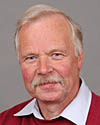 Exemplary lecturer and tutor at Sheffield University with exceptionally wide geological interests
Exemplary lecturer and tutor at Sheffield University with exceptionally wide geological interests
Martin Whyte, born 27 March 1945 in Edinburgh, was the eldest of three children of the Rev. James Whyte and his wife Elisabeth. He attended primary school in Oban, where beach-combing on his way home sowed the seeds of his enthusiasm for natural history and, later, palaeontology. The family returned to Edinburgh, where he attended Daniel Stewart’s College, before moving to St. Andrews in 1957. Martin attended Madras College from 1957-1963 where he met Carol, his future wife. He went on to complete a BSc Honours Degree (2.1) at St. Andrews (1967), before moving to Edinburgh where he was awarded a PhD (1973) for his thesis, ‘Palaeoecology of Upper Viséan Marine Mudstones, near Dunbar, East Lothian’. Martin and Carol were married in St Andrews in 1968.
In 1971 Martin moved to Hull University where he was a Research Assistant in Geology until 1973, and then a Research Fellow until 1974, when he was appointed to a lectureship in the Department of Geology, University of Sheffield. He remained in Sheffield until retiring in 2010, being promoted to Senior Lecturer in 1997.
Martin’s geological interests were exceptionally wide and developed considerably throughout his career. Initially it was his expertise in Carboniferous stratigraphy and palaeoecology that dominated his publications, and in the 1970s to 1980s he completed works on Carboniferous stratigraphy, bivalves, barnacles and crinoids. However, papers on ‘Turning Points in Phanerozoic History’ published in Nature and thematic volumes demonstrated his ability to envisage the broader picture.
In the early 1980s he became interested in the relatively unexplored world of dinosaur footprints from the Middle Jurassic of Yorkshire. He recognised the potential of this topic for a modern scientific approach, and was responsible, in 1996, for introducing volunteers from Earthwatch International to spend up to three weeks a year searching for dinosaur footprints along the Yorkshire coast. These finds resulted in numerous publications, and put the Yorkshire dinosaur tracks on the international stage. The success of this research programme led to invited talks at both national and international meetings.
Despite the efforts devoted to the dinosaur track project, Martin also pursued other geological interests. He worked on biomineralisation in barnacles and gave invited talks on the subject in Japan. His recognition of phosphatic barnacles is regarded as being the most significant advance in this group of organisms since the work of Darwin. His study of soft tissue preservation in bivalves led to collaborative work searching for exotic phosphatisation of parasites and other organisms. In addition, research on dinosaur egg morphology and preservation with Chinese colleagues resulted in presentations at international meetings in France and the USA. Most recently, he identified the largest known trackway of a eurypterid from the Lower Carboniferous of Scotland.
Martin was a member of eight learned societies, serving on the Council of The Geologists’ Association (1997-2001) and as a Council Member (1984, 2005), Secretary (1988-1989) and President of the Yorkshire Geological Society (2006-2008). He was a regular and frequent visitor to the Geological Society’s library in Burlington House.
Martin was an exemplary lecturer and tutor. He was never too busy to see students, was an enthusiastic lecturer, and was a helpful, supportive and patient supervisor to his numerous postgraduate students. As a colleague, he was always willing to answer any query presented to him; frequently using his meticulously organised reprint, textbook and specimen collections.
Martin died 25 June 2013 in Sheffield, and is survived by his wife, three children (Jennifer, Carolyn and Andrew) and three grandchildren.
Michael Romano (with help from Fergus Gibb and Roger Hewitt in preparing the text)